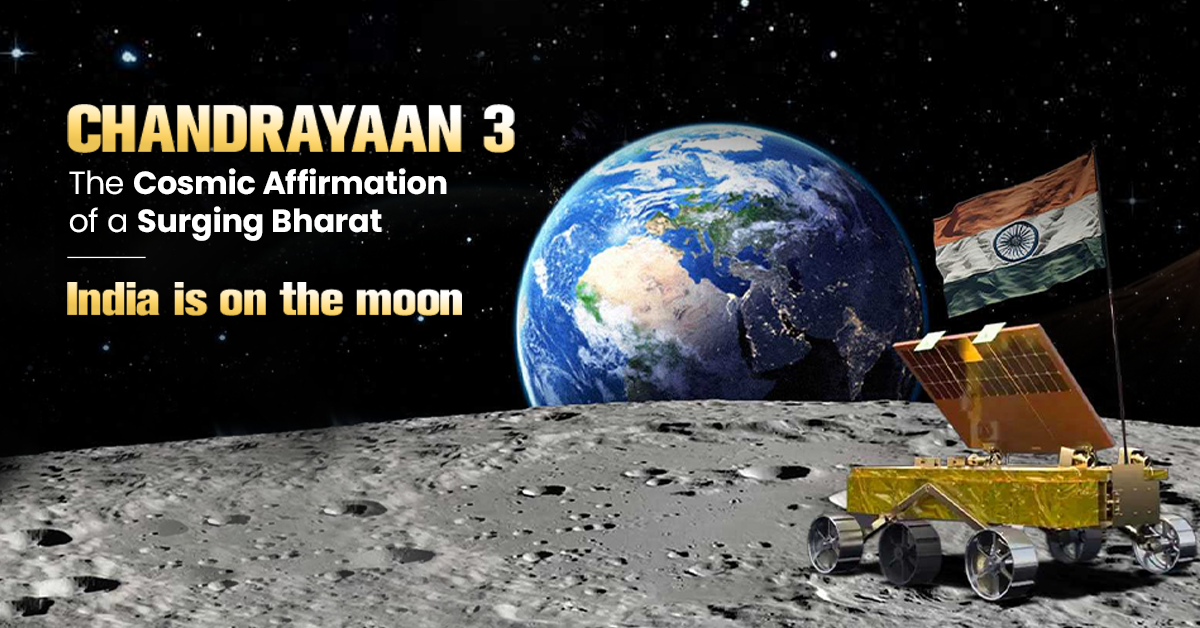CHANDRAYAAN 3: The Cosmic Affirmation of a Surging Bharat
India is on the moon. A dream, more a spurting aspiration, of a billion-and-ahalf people, rooting for the Tiranga on the lunar South Pole, an unexploredambit of possibilities, has come true. Chandrayaan 3 is only a pedestal forIndia, rather mankind’s everlasting venture into the fathomless cosmos;corresponding to the dawning of a new era here on Earth, an era heralded bythe world’s most populous nation, rooted in the grit, ambition and honour ofthe 1.5 billion Indians.

On 23 August 2023, more than 1500 years after Aryabhata’s marvel of calculating the sidereal (rotational) period of the Earth, in an age of pioneering Bhartiya or Vedic wisdom, discoveries and philosophies of science, astronomy and mathematics; Bharat that is now India, once again triumphed with the landing of the Chandrayaan 3 on the moon. An elated nation sensed the inherent scientific sagacity that for aeons deemed Bharat as the tallest global hub of astronomical and mathematical concepts and ideas.
On Wednesday, August 23, the Indian Space Research Organisation’s (ISRO) YouTube, featuring Chandrayaan 3’s landing, was the most-watched ever with over 8 million concurrent viewers. In the same month, ISRO gained the second-most followers on X, formerly known as Twitter. Indian social media broke down with overwhelming emotions, gratitude but above all pride in the nation’s stellar accomplishment. The world too, stunned by India’s space prowess, and flaring global stature, heaped unending extols on the world’s demographically youngest nation. The Prime Minister, then in South Africa for the BRICS Summit, congratulated ISRO Scientists over a telephone call. Such was the national fervor of the accomplishment that Modi landed in Bengaluru, upon arrival, and directly headed to ISRO headquarters to congratulate and address the scientists and workers associated with the mission.
Unequivocally, India becoming only the fourth nation to land on the moon, and the first one to do so near its southern pole, is a multidimensional attainment. It is one of the first explicit indicators of our nation’s unrivaled global eminence in near posterity. It is an affirmation that developments of Independent India’s 76 years are hurling us into the right direction. For decades India reeled under the challenges of poverty, unemployment, economic stagnation, and inadequate essential amenities inter alia. These issues still constitute the major challenges nationally. However, India is also prospering, efficiently addressing these challenges, and striving for its rightful place in the global order. As per a recent UNDP report, 415 million Indians exited poverty in a mere span of fifteen years(2005-2021); implying more than the whole population of the US was pulled out of poverty in fifteen years. In the past decade, it is in India that the world’s most widespread and efficient digital public infrastructures emerged, unicorns surfaced, covid vaccines were produced, commerce multiplied, and elementally, the middle class burgeoned.
As Covid stroked the global economy, beating it into smithereens, and plummeting all major economies; India’s exception was exceptional. As International Monetary Fund’s (IMF)Managing Director, Kristalina Georgieva, remarked – “India deserves to be called a bright spot on this otherwise dark horizon” – she referred to the enduring consumerism in the country. Robust consumerism, or domestic demand, was the cornerstone of our economic resilience and the debility of the other major economies.
The new space race of the 21st century is definitely different from the one during the Cold War, when the erstwhile USSR and the US competed for dominance. In the space race of the 21st century, national participants have increased, and even the private sector is emerging as a front-runner. The novelty of this space race lies in the participation of recent powers such as China and India, a reflection of the transforming political landscape back on Earth. Despite increased participation and stakeholders, the ability of a nation to perform a space maneuver is highly prestigious, and only a few have developed the technologies and the facilities to do so. While the National Aeronautics and Aerospace Administration (NASA), the American space agency, is the clear leader in the sector, things are heating up.
The International Space Station (ISS), launched in 1998 by the collaborative efforts of NASA, Roscosmos (Russia), ESA (Europe) and JAXA (Japan), to support scientific research and other activities requiring the unique attributes of humans in space; faced imperilment in 2021, when Roscosmos intended to withdraw from the project. Although later deferred,it was a clear indicator that space cooperation is not immune to geopolitical tensions.Meanwhile, on 29 April 2021, China launched its own space station, Tiangong 1, a clear divergence from the West-led efforts in space exploration. Following China, was India, ISRO’s then Chief, Dr. K. Sivan, in 2019, on being asked if India will join the ISS, remarked- “India plans to have its own space station”. India’s principle-based global political strategy of resolutely pursuing its national interests finds parallels in its space ambitions.China and India, the inevitable great powers of the world, are reaffirming their inevitability through unceasing efforts to be unequaled space powers. Russia, formerly USSR, the erstwhile superpower, declining, is only augmenting the stature of China and India in the space sector. While China’s space program is ahead of India’s, however, the latter’s success with Mangalyaan, the Mars Orbiter Mission that made India the first country to place a satellite in Mars’s orbit in the first attempt, followed by multiple successful commercial satellite launches, Chandrayaan 3’s marvel and ISRO’s ambitious streak of flights ahead, including intentions of manned missions – make the country available contender.
In fact, just days after Chandrayaan 3’s successful landing, ISRO launched its first solar mission – Aditya-L1. Launched on 2 September 2023, the coronagraphy spacecraft aims to study the solar atmosphere and the drivers of space weather. The fact that ISRO’s primary solar mission comes before the dust could settle on Chandrayaan 3’s staggering success is a testimony to the space agency’s astounding abilities to undertake multiple climacteric missions simultaneously.
ISRO’s gems of Chandrayaan 3 and Aditya-L1 mission have veritably buoyed global confidence in India’s space abilities. Nevertheless, the most tantalising aspect of ISRO’sengrossing accomplishments is their frugality. After Chandrayaan 3’s success, theinternational media was buzzed with contrasts between the Hollywood space movies budgets and Chandrayaan 3’s stunning budget. Social media was swamped with juxtapositions such as that between Christopher Nolan’s movie Interstellar, cost $ 165 million, and Chandrayaan 3, cost $ 75 million, a $ 90 million difference. Hollywood movies such as The Martian, cost $ 108 million, Gravity, cost $ 100 million, and even Bollywood movies as Adipurush, cost $ 90 million, supersede significantly ISRO’s budget for Chandrayaan 3.
A major limitation for nations to embark on a full-fledged space program is the exorbitant costs involved. Excessive costs on almost everything, high risk and relevantly unyielding results were the prime causes that sabotaged the first space race. This time, while nations such as the US, China and Japan rely on their economic supremacy to fuel their space ambitions; India is ascending by its striking ingenuity and innovation. ISRO’s sensational efficiency and mind-boggling frugality are a revolution in the space sector, likes of which can be found only in Elon Musk’s Space X. ISRO’s frugal approach is provoking great international keenness on its cost-effective methods and overall mission execution.
The grim reality, rather history, Indians are aware of their nation once being a “सोनेकीचिड़िया” or a “bird of gold”, which was plundered by centuries of foreign invasions and atrocities. The greatest civilisation of all time, which witnessed vast, immensely resourceful and globally illustrious empires such as that of the Mauryas, Guptas, Satavahanas, Cholas, Prathiharas, Pallavas etc. was a land of pride, poise, honor and culture. Since time immemorial, the Indian subcontinent was the heart of knowledge, philosophy, literature and wisdom. Ancient Indian intellectuals such as Aryabhatta, Bhaskaracharya, Brahmagupta, Sushruta, Charaka, Varahamihira, and Kanada were pioneers in mathematics, astronomy, philosophy, botany, anatomy, medicine, surgery etc. and demonstrated the subcontinent’s promise to intellectual honing, discoveries, discourses and percipience. Ancient Indian texts such as those of the Vedas, Puranas, Upanishads, Shulba Sutras, Vedang literature, Surya Siddhanta, and Sushatra Samhita introduced the world to gravity, decimal system, the value of pi, Earth’s rotation, trigonometry, zero, types of surgeries, veterinary medicine, metallurgy and architecture.
An even more startling fact is that the Indian subcontinent maintained its economic, intellectual and cultural edge over the world for aeons. Even as recently as the Mughal Dynasty in the subcontinent, the year 1700, the subcontinent constituted a quarter of global GDP. It is not the immensity of Bharat’s riches but its perseverance over centuries and centuries that make it an incredible giant of human history. The share of the subcontinent’s wealth in the world only explodes as we further turn back the clock. Unfortunately, the greatest tragedy to have ever occurred with India is not that of the English rule. But the degeneration of our society, culture and thereafter economics by forgetting and neglecting the legacy of Bharat. The one thing greater than the riches and magnanimity of the Indian people was the greed and bestiality of the British. $ 45 trillionis the estimation of the English heist in India, the greatest in world history ever. However, money was not the most precious thing lost, rather it was the pride, dignity and legacy that the English ravaged in us.
India at Independence was of no measure to the prodigious Bharat it once was. The average life span was a mere 36 years, 70 % – 80 % of the population perished in poverty, the illiteracy rate was a daunting 83 % and the per capita income was a meagre 265Rupees. The English, fearing a future resurgence and welting for themselves, successfully deployed their master doctrine of division by inflating communal tensions and the demand for an Islamic state of Pakistan. The partition remains one of the greatest human tragedies.
After wronging the subcontinent for over 200 years, murdering millions, and looting trillions, the English of their self-proclaimed standards, dared to take potshots at India and her ability to survive as a nation. But at this moment, pragmatically, a nation as colossal and deprived as ours, consisting of multitudes of ethnicities, religions, and languages, could crumble at any point. So why didn’t we?
The answer lies in our civilizational values and ethos that our people and leadership clenched to. Bharat’s endurance played its spell and our forefathers bore the nation the most just constitution in human history. The constitution honored and heeded to all citizens alike. It still binds us today and is the essence of modern India’s might.
Empowered by the constitution, the leadership and the citizens of the country, India faced the many grave challenges head-on and prevailed. We progressed on all major economic parameters and our society and culture were resuscitated with greater inclusion and understanding of issues. Our growth was steady but it was principle-based. Democracy, citizen rights or freedom were not compromised for economic clout. Unlike in China, where the state is affluent but the citizens are deprived of basic rights, freedom and liberty.
Chandrayaan 3, 75 years after Independence, is a poignant and proud moment not only in India’s space odyssey but also on its path to reclaim the treasures of Bharat. It is a testimony to the resilience, perseverance, and ambitions of modern India and her people. It is a celebration of our wide-ranging accomplishments of the past 75 years. It is the promise of India recuperating to Bharat and forging the destiny of mankind.

